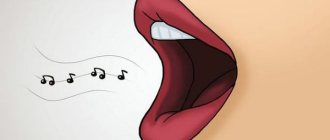Voice disorders
Organic voice disorders
Voice disturbances in chronic laryngitis are caused by damage to the neuromuscular apparatus of the larynx and non-closure of the vocal folds.
Voice defect is expressed by loss of normal sound, severe fatigue, and sometimes the inability to perform vocal tasks. Characterized by unpleasant subjective sensations in the throat - scratching, soreness, rawness, sensation of a “lump”, pain, pressure. In the case of peripheral paralysis and paresis of the larynx, the voice may be completely absent or have a hoarse sound. Voice impairment is accompanied by severe speech fatigue, reflex cough, choking, and respiratory distress. Discoordination of phonation and breathing significantly aggravates the defect.
Voice disorders associated with benign and malignant tumors of the larynx develop gradually as the tumors grow. After any, even gentle, surgical intervention on the larynx, transient voice disturbances occur. When the larynx is removed, a person completely loses his voice; in this case, the respiratory function is sharply impaired, since the trachea and pharynx are separated.
With central paresis and paralysis of the larynx, observed with dysarthria and anarthria, the voice becomes weak, quiet, intermittent, dull, monotonous, often with a nasal tint.
Organic voice disorders that occur in a young child are accompanied by a lag in speech development, a delay in the accumulation of vocabulary and the development of grammatical structures, impaired sound pronunciation, communication difficulties and limited social contacts. Voice disorders that develop in adulthood may lead to professional unsuitability.
Functional voice disorders
Being a peripheral functional voice disorder, phonasthenia is an occupational “disease” of people in voice-speech professions. Manifestations of phonasthenia include the inability to arbitrarily regulate the sound of the voice (strengthen or weaken), interruptions (misfires) and rapid fatigue of the voice, hoarseness. In the acute period of phonation, the voice may disappear completely. In most cases, phonasthenia does not require treatment; The voice recovers on its own after a period of rest.
With hypotonic dysphonia, due to paresis of the internal muscles of the larynx, non-closure of the vocal folds develops, which is manifested by hoarseness, vocal fatigue, pain in the muscles of the neck and back of the head; in severe cases, only whispered speech is possible. With hypertonic dysphonia, caused by tonic spasm of the laryngeal muscles, the voice is distorted, becomes dull, rough; in aphonia – does not occur at all.
A pathological mutation can be expressed in the preservation of a high-pitched voice after puberty, voice instability (alternating low and high tones), dysphonic sound, etc.
Functional voice disorder of a central nature (hysterical mutism, psychogenic aphonia) is characterized by a complete simultaneous loss of voice, the inability to whisper speech, but at the same time preserved sonorous laughter and cough. An important differential feature is the variability of the form of non-closure of the vocal folds. The course of psychogenic voice disorder is long-term, and repeated relapses are possible after voice restoration.
Diagnosis of hypotonic dysphonia
When examining a patient, a phoniatrist sees during phonation a glottis of different sizes and locations - in the middle, posterior parts of the vocal folds, or even along the entire length. This means that the vocal folds do not close together. And because of this, the air does not linger in the subglottic space, a full-fledged strong voice is not formed, the voice is weak, the voice is quiet, the voice trembles when singing, it is impossible to talk for a long time. The severity of hoarseness may vary, the strength of the voice decreases, vocal fatigue appears, and the timbre changes. This makes it difficult for vocal educators, teachers, coaches, the training of future singers, and the performance of professional duties for everyone.
Treatment
A course of phonopedic classes with a phonopedist is aimed at restoring the tone of the vocal folds and removing “clamps” from the larynx. A phonopedic therapist helps to understand the causes of incorrect voice guidance, develop a personal course of phonopedia, and restore voice function. This comprehensive approach allows you to restore your voice and prevent recurrence of laryngeal disease in the future.
We should not forget that ignoring a problem with the voice will lead to the consolidation of incorrect phonation, deterioration of vocal function, and may become the beginning of the emergence of organic pathology of the vocal apparatus - laryngitis, laryngeal tumors.
Diagnosis of voice disorders
The most accurate diagnosis for voice disorders can be made by a doctor based on medical history, examination and some other types of research.
Diagnosis may require indirect laryngoscopy using a mirror and a forehead lamp. If this procedure does not give the desired result, it can be performed using a flexible fiberoptic laryngoscope. This procedure is performed under local anesthesia. In case of acute inflammation of the larynx, the patient can see redness of the larynx without the presence of discharge. Using this study, benign and malignant tumors of the larynx can also be detected.
If the laryngeal nerve is injured, the patient may experience vocal cord paralysis on one side. If this pathology is detected, the doctor must conduct an additional examination to identify the factors that provoked this condition.
When examining the neck, the doctor must rule out the presence of a goiter. If the supraclavicular lymph nodes are detected to be enlarged, the doctor may suspect the patient has tumors in the esophagus.
During an examination of the chest organs, the specialist must exclude the patient from collapsing lung lobes and inflammation of the pleura, which often accompanies lung cancer.
In some cases, it may be necessary to conduct laboratory and instrumental studies, which include:
- ESR - performed for inflammation of the larynx, neoplasms;
- RGC - for malignant lung tumors;
- tensilone test - for patients with autoimmune neuromuscular diseases;
- computed tomography of the cervical spine - prescribed for patients with laryngeal or thyroid cancer to determine its stage;
- computed tomography of the chest - performed for tumors in the lungs, an increase in the diameter of the thoracic aorta;
- endoscopy - prescribed for suspected esophageal cancer;
- aortography of the aortic arch;
- OAC - prescribed to patients with inflammation of the larynx;
- biopsy - for thyroid tumors.
Some patients are recommended to be additionally examined by a phoniatrist and a neurologist.
How to save a teacher’s voice: 10 tips from a phoniatrist
The human voice is a unique phenomenon. Every sound we make is the result of complex anatomical and physiological processes. It is the voice that allows us to fully communicate, express thoughts and emotions, and most importantly, speak. Of course, the human voice is a priceless gift that is difficult to overestimate. But for some people it is not only a tool of communication and a way of self-expression, but also a valuable capital in cases where a person’s professional activity is directly related to the use of this tool. And, of course, representatives of the “voice” professions need to take care of their working instrument, take care of it and know the basic rules for safe use, because, like any other “tool,” the voice can break, “deteriorate” and fail. Today we will talk about the voice of the teacher - educator, teacher, teacher. After all, it is the voice that can be called the calling card of these professions. Teaching activity requires not only deep knowledge, a high level of erudition and culture, dedication and sincerity. The voice also plays an important role in it. At all times, an important indicator of pedagogical skill has been and is the teacher’s speech, its technique, purity, literacy, lexical richness, and expressiveness. A teacher, perhaps, has to use speech more than a representative of any other profession. Diseases of the vocal folds (this is the name in professional medical vocabulary for what we are accustomed to call vocal cords in everyday speech) of teachers are an occupational risk of teaching.
Various types of hoarseness, hoarseness, dysphonia and partial or complete loss of voice among teachers appear very often due to increased stress on the vocal apparatus. And this is easy to explain. Firstly, the duration of speaking affects: teachers every day have to speak for many hours almost without stopping, and many of the representatives of this profession do not allow their vocal apparatus to rest even during breaks, continuing to communicate with colleagues. Secondly, the volume of speech: many teachers, trying to convey knowledge to their students, religiously follow the rule “The louder, the better,” thereby exacerbating the load on the already tense vocal apparatus. Therefore, it is especially important for representatives of “voice” professions to know how to protect their vocal apparatus and what to do if something does happen to their voice.
In our article, otorhinolaryngologist, phoniatrist at the SMITRA Clinic, Egor Evgenievich Demidov, will give 10 valuable tips on how a teacher can preserve his main instrument - his voice.
Tip #1.
Don't neglect early diagnosis.
A study of the state of the speech apparatus among representatives of the teaching professions is mandatory. Especially if you notice any pathological manifestations related to your voice. A decrease in voice strength, a narrowing of the range, a decrease in the flight of the singing voice, hoarseness of the voice, a decrease in the sonority of the voice, difficulty speaking, voice fatigue can be the initial manifestations of diseases of the speech apparatus and require the intervention of a doctor.
Tip #2. Allow your voice to rest.
Use every small opportunity to give your voice a rest. In other words, just keep quiet. Many teachers forget about this and continue to have conversations with colleagues and students even during breaks, and with the same intensity. As a result, in the evening there appears hoarseness, voice fatigue, and various unpleasant and painful sensations in the throat area.
Tip #3. "Silence is gold".
A good habit will be 2-3 hours of silence after the end of the working day. If necessary, during this period, use speech minimally: phrases should be short, concise, and the speech itself should be very quiet. Avoid long and, especially, loud conversations during this period.
Tip #4. Don't get too cold!
The voice apparatus of a voice-speech specialist is very sensitive to sudden temperature changes. Therefore, in the cold season, do not go outside immediately after vocal exercise; wait 15-20 minutes; the vocal apparatus, “warmed up” by the exercise, needs time to cool down. You can also cool your vocal folds by drinking a few sips of room temperature water before going outside.
Tip #5. Get treatment on time.
The health of the upper respiratory tract is important for the health of the vocal apparatus. Diseases of the nose and paranasal sinuses, tonsillitis, tonsillitis can cause and maintain inflammatory changes in the larynx. Therefore, if you have any diseases of the upper respiratory tract, be sure to consult an otolaryngologist for diagnosis and treatment. If acute colds occur, you must be immediately released from work. Consult your doctor at the first appearance of a cold and maintain a strict vocal routine. Return to work only after elimination of inflammation and complete restoration of speech functions, since, for example, untreated acute laryngitis can become chronic and incapacitate the teacher for a long time, depriving him of his voice.
Tip #6. Try to be less nervous.
The work of a teacher is often very emotional and associated with nervous tension and stress. Therefore, one of the reasons for hoarseness or even complete loss of voice in a teacher is disorders of the nervous system. Try to organize your personal and professional life so that the nervous system is not subjected to strong unexpected stress, mental trauma, or overstrain. If you feel that you are not able to cope with accumulated stress and emotional fatigue on your own, contact a professional - a neurologist or psychotherapist.
Summer - relax! One of the advantages of teaching is a long vacation, almost two months. Use it wisely, allow yourself and, in particular, your voice to relax and recover. Do not engage in professional activities during this period; if possible, avoid part-time jobs. Take care of your voice, speak less, quietly, calmly.
Tip #7. Avoid irritants.
The teacher's working organ - the vocal apparatus - is very sensitive to all kinds of stimuli. Do not indulge in spicy foods, too hot or cold drinks, and give up alcohol. The consumption of these products negatively affects the mucous membrane of the mouth, pharynx and underlying sections. No less harmful for specialists in voice-speech professions is smoking, which irritates not only the upper but also the lower respiratory tract, causing severe salivation.
Tip #8. For women.
It is worth remembering that during menstruation the vocal apparatus is most vulnerable and requires special care.
During this period, a woman’s vocal folds swell somewhat, and her voice quickly gets tired. Overstraining the vocal apparatus these days is strictly contraindicated. Tip #9.
For experienced workers. The sensitivity of the vocal apparatus and its susceptibility to negative influences increases in direct proportion to age. The performance of the speech apparatus decreases with age, and its sensitivity to colds and overexertion, on the contrary, increases. Taking this into account, older workers in “voice” professions must follow hygiene rules more strictly.
Tip #10. If your voice suddenly disappears...
What to do if you suddenly suddenly, right during a lesson or class, lost your voice? Are there “magic” folk methods to quickly bring it back? And can they be used? The answer is clear - no. In case of sudden loss of voice, the first thing to do is consult a phoniatrist and do not self-medicate! The best thing you can do before seeing a doctor is to drink more warm liquids (tea, compotes, fruit drinks), not whisper and keep vocal strain to a minimum.
Follow our simple tips and rest assured that your vote will thank you! Your main working instrument will serve faithfully for many years, sounding confident, inspired, expressive, and positive. Good health to you!
The material was prepared with the participation of an otorhinolaryngologist, phoniatrist at the SMITRA Clinic,
Egor Evgenievich Demidov . © 2010-2021 SMITRA. All rights reserved. No material on this site may be copied or used without written permission except for private, non-commercial viewing.
Classification of voice disorders
In medicine, voice disorders are divided according to the degree of manifestation of the disorder into:
- Dysphonia is a disorder in which the strength of the voice decreases, its color and pitch change. With dysphonia, the voice becomes hoarse, lowers, and becomes hoarse;
- aphonia is a disorder during which the voice disappears completely. With aphonia, a person can only whisper.
According to the mechanism of development, these disorders are divided into:
- organic;
- functional.
Based on the location of lesions of the vocal apparatus, voice disorders are:
- central - voice disorder resulting from pathological processes occurring in the middle of the vocal apparatus;
- peripheral - pathological changes occur in the peripheral part of the vocal apparatus.






